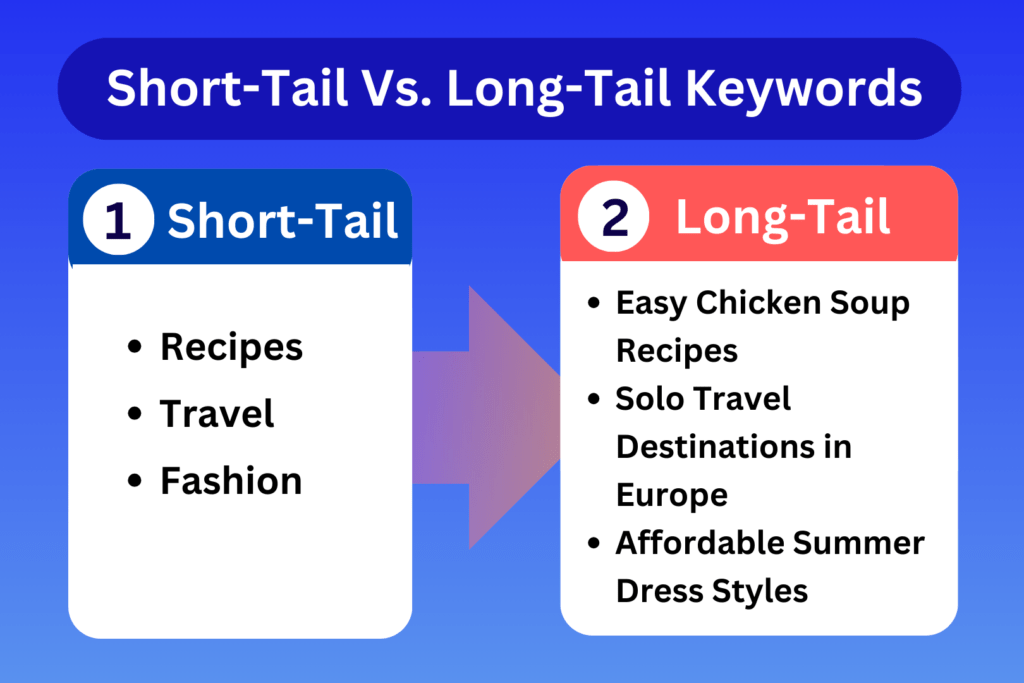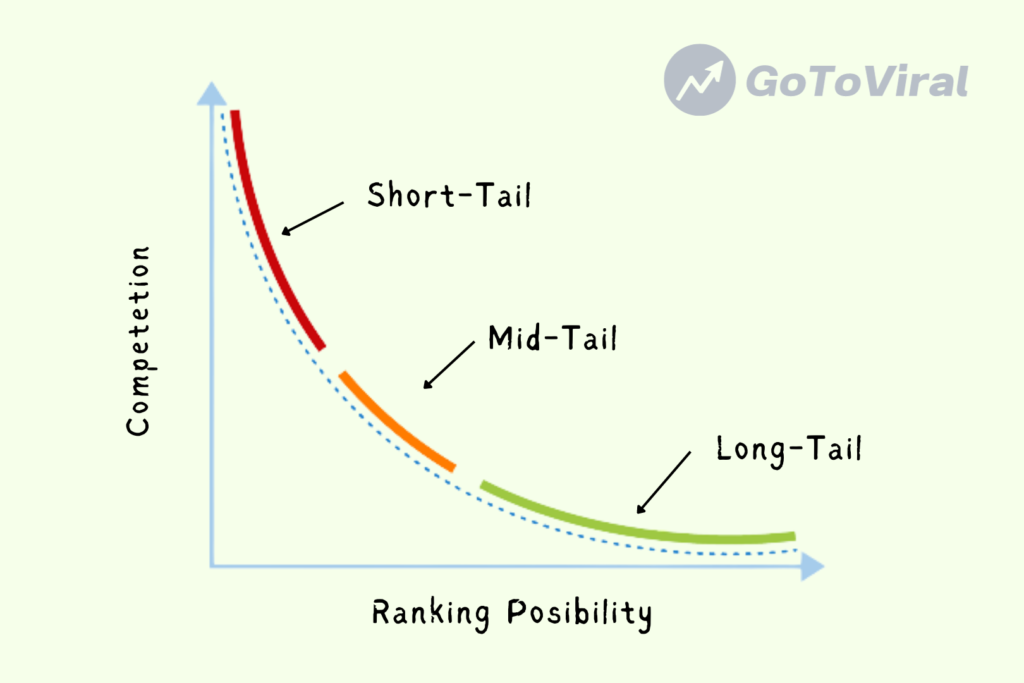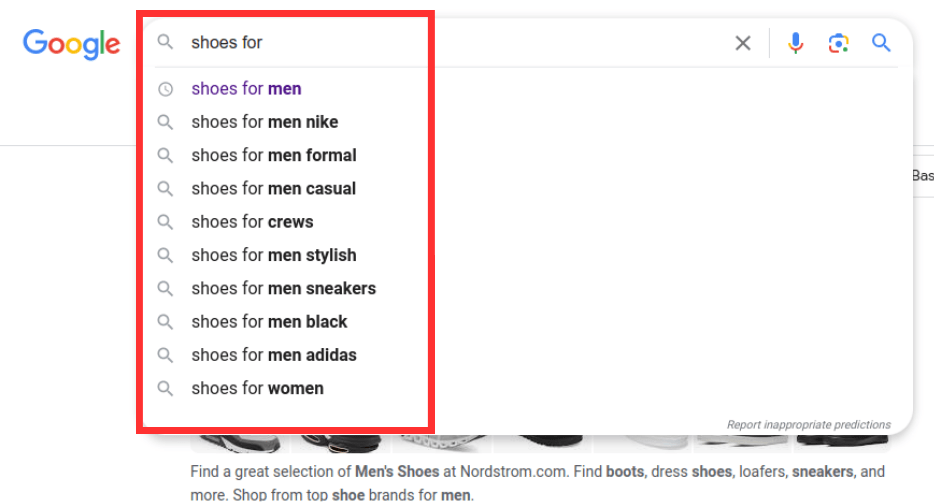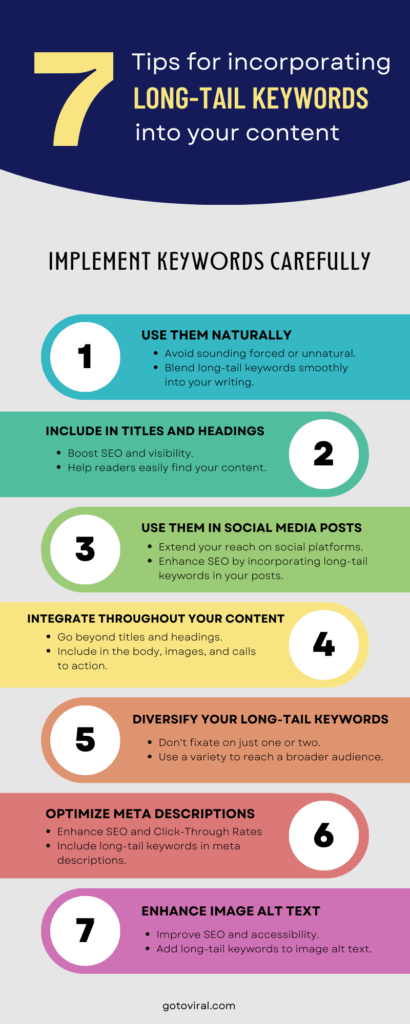Are you searching for some excellent examples of how to use long-tail keywords effectively? If so, your search ends here!
In this blog post, you’ll discover 7 examples of long-tail keywords. You’ll also learn what long-tail keywords are, their significance, the different types, and valuable tips and tools for integrating them into your content strategy.
So, sit tight and dive into this informative piece of content.
Let’s begin!
- What are long-tail keywords in SEO?
- Why are long-tail keywords important?
- How many types of long-tail keywords are there?
- How do I find a long-tail keyword?
- Tips to keep in mind while choosing keywords
- 7 Best Examples of Long-Tail Keywords
- 7 tips for incorporating long-tail keywords into your content
- Tools and Resources for Long-Tail Keyword Research
What are long-tail keywords in SEO?
Long-tail keywords are specific and highly targeted search phrases or keywords that users enter into search engines.
These keywords typically consist of three or more words. Also, they are more detailed. Most of the time, long-tail keywords reflect the specific needs and interests of the searcher.
For example, the keyword “shoes” is a head keyword or short-tail keyword. On the other hand, the keyword “women’s running shoes size 7” is a long-tail keyword.

Long-tail keywords are less competitive than head keywords. But they can be more effective for driving traffic to your website because they are more specific.
Why are long-tail keywords important?
Long-tail keywords play a crucial role in every SEO plan. They can elevate your rankings in SERPs for relevant searches. And this can lead to more traffic and conversions on your website.
Here are a few reasons why it will benefit you:
Attracting a Specific Audience:
Long-tail keywords are more specific than general keywords, so they attract people who are more likely to be interested in what you have to offer.
For example, if someone searches for “best running shoes for women”, she is more likely to be interested in buying a pair of running shoes than someone who simply searches for “shoes.”
By tailoring your content to these specific users, you can connect with people who are more likely to become your customers, loyal subscribers, or engaged readers.
Reduced Competition and Easier to Rank:
Long-tail keywords usually have less competition compared to short-tail keywords. This means it’s often easier to get your content noticed by search engines when you use these longer, more specific phrases.

As it has lower competition, it’s easy for you to rank for those keywords.
Increase Voice Search Visibility:
As voice search becomes more popular, people are using more conversational language when they search.
Long-tail keywords often align with these natural, conversational queries, making your keywords essential for voice search optimization.
Diverse Content Creation:
Targeting long-tail keywords allows you to cover a wide range of specific topics within your niche. This can attract a broader audience and help establish your expertise.
Enhancing Relevance:
When you target long-tail keywords, you’re more likely to create content that is directly relevant to what people are searching for. This can improve your click-through rates (CTRs) and conversion rates.
How many types of long-tail keywords are there?
There are many different types of long-tail keywords. But based on their search intent they can be generally divided into 3 categories:
Informational long-tail keywords:
These keywords are used by people who are looking for information on a particular topic. For example, “What are the symptoms of the flu?” or “How to change a tire.”
Transactional long-tail keywords:
These keywords are used by people who are ready to buy a product or service. For example, “Discover top restaurants in San Francisco.” or “Best organic skincare products for sensitive skin in winter.”
Navigational long-tail keywords:
These keywords are used by people who are looking for a specific website or web page. For example, “Facebook login page” or “OpenAI GPT-3.5 documentation”
Make sure that when you are choosing long-tail keywords, it is important to consider your business goals and your target audience.
If you are looking to generate leads and sales, you should focus on transactional long-tail keywords.
On the other hand, if you are looking to build brand awareness and drive traffic to your website, you can focus on informational and navigational long-tail keywords.
How do I find a long-tail keyword?
There isn’t a single prescribed method for finding long-tail keywords. On the other hand, you can get inspiration from various sources and methods.
Here are several channels you can explore to extract keyword ideas:
1. Use Google Suggest.

When you start typing a keyword into the Google search bar, Google will suggest other keywords related to your search. These are long-tail keywords.
2. Use keyword research tools.
There are a number of keyword research tools available, such as Google Keyword Planner, Ahrefs, and SEMrush. These tools can help you find long-tail keywords with low competition and high search volume.
3. Look at the “Related questions” section.

At the bottom of the Google search results page, there is a section called “Related questions.” This section contains a list of related queries that people have asked about your topic. These are great long-tail keywords to target.
4. Look at your website analytics.
Your website analytics can show you which keywords people are using to find your website. You can use this information to identify long-tail keywords that you are already ranking for and to find new long-tail keywords to target.
5. Analyze your competitors.
Take a look at your competitors’ websites and see what keywords they are targeting. You can use this information to identify long-tail keywords that you are not targeting but that your competitors are.
Once you have a bunch of those detailed, specific keywords, you can start to use them on your website and in your marketing campaigns.
You can also use them to create new content, such as blog posts and articles.
Tips to keep in mind while choosing keywords
Congratulations, as you discovered a ton of keyword ideas. But now, is it difficult for you to select which one is appropriate for your blog post? Or is it difficult for you to know where to start? If yes. Follow these tips:
- Be specific. The more specific your keywords, the less competitive they will be.
- Use modifiers. Add modifiers like “best,” “cheap,” “easy,” or “fast” to make your keywords more specific.
- Use question keywords. Target keywords that start with words like “what,” “why,” “how,” and “when.”
- Use location keywords. Include the name of a city, state, or country in your keywords.
- Use synonyms and related keywords. Use a tool like Google Keyword Planner to find synonyms and related keywords.
We hope these tips will help you choose the right keyword for your blog post.
7 Best Examples of Long-Tail Keywords
Here are your examples of keywords. We break down each keyword so that you can easily catch what’s happening inside. Also, we add some additional variations to each head keyword.
Let’s move on.
#Example 1: “Smartphones”
Long-tail: “Budget smartphones under $500 with a long battery life.”
This keyword is likely to be searched by people who are seriously considering buying a phone that meets those criteria.
let’s break down this keyword into several parts:
Budget: This tells us that the searcher is looking for a phone that is affordable.
Under $500: This sets a specific budget limit for the searcher.
Smartphones: This tells us that the searcher is looking for a smartphone, which is a type of mobile phone with advanced features such as internet access and a touch screen.
Long battery life: This tells us that the searcher is looking for a phone that has a battery that can last for a long time on a single charge.
By searching for this keyword, the searcher is indicating that they are looking for information on budget smartphones that are under $500 and have a long battery life. This is a very specific search intent, and it is likely that the searcher is close to making a purchase decision.
Here are some other variations for this head keyword:
- The 5 Best Budget Smartphones Under $500 With a Long Battery Life
- How to Choose the Best Budget Smartphone Under $500 With a Long Battery Life
- Review of the [Phone Name]: A Budget Smartphone With a Long Battery Life
#Example 2: “TV shows”
Long-tail: “Best TV shows to binge-watch during the holidays”
This keyword is likely to be searched by people who are looking for recommendations for TV shows to watch during the holiday season.
let’s break down this keyword into several parts:
Best: This tells us that the searcher is looking for the best TV shows, rather than just any TV shows.
TV shows: This tells us that the searcher is looking for TV shows rather than movies or other types of content.
To binge-watch: This tells us that the searcher is looking for TV shows that they can watch for several hours at a time.
During the holidays: This tells us that the searcher is looking for TV shows that are appropriate to watch during the holiday season.
By searching for this keyword, the searcher is indicating that they are looking for a list of the best TV shows to watch during the holiday season. This is a very specific search intent, and it is likely that the searcher is close to making a decision about what to watch.
Here are some other variations for this head keyword:
- Best TV shows to watch for fans of [genre] (e.g., sci-fi, comedy, drama)
- The most popular TV shows on Netflix
- New and upcoming TV shows to watch in 2023
#Example 3: “Online courses”
Long-tail: “Free online coding courses for beginners with certificates”
This keyword is likely to be searched by people who are interested in learning to code but don’t have a lot of money to spend on education.
let’s break down this keyword into several parts:
Free: This tells us that the searcher is looking for courses that are free to take.
Online: This tells us that the searcher is looking for courses that can be taken online, which is convenient for people who are busy or who live in remote areas.
Coding: This tells us that the searcher is interested in learning to code.
Courses: This tells us that the searcher is looking for structured courses that will teach them the basics of coding.
For beginners: This tells us that the searcher is a beginner and is looking for courses that are appropriate for their skill level.
With certificates: This tells us that the searcher is interested in earning certificates of completion for the courses they take.
By searching for this keyword, the searcher is indicating that they are very interested in learning to code and are serious about finding a free online course that will teach them the basics and give them a certificate of completion. This is a very specific search intent, and it is likely that the searcher is close to making a decision about which course to take.
Here are some other variations for this head keyword:
- Online courses with job placement
- Free online coding courses for beginners with certificates in data science
#Example 4: “long tail keyword”
Long-tail: 7 Best Examples of Long-Tail Keywords to Boost Your SEO
This keyword is likely to be searched by people who are interested in learning more about long-tail keywords and how to use them to improve their SEO.
let’s break down this keyword into several parts:
Examples: This tells us that the searcher is looking for specific examples of long-tail keywords rather than just a general definition of long-tail keywords.
Long-Tail Keywords: This tells us that the searcher is interested in learning more about long-tail keywords, which are a type of keyword that is more specific and less competitive than short-tail keywords.
Boost Your SEO: This tells us that the searcher is interested in learning how to use long-tail keywords to improve their SEO, which is the process of optimizing a website or blog to rank higher in search engine results pages (SERPs).
By searching for this keyword, the searcher is indicating that they are interested in learning more about long-tail keywords and how to use them to improve their SEO. This is a very specific search intent, and it is likely that the searcher is serious about learning more about this topic.
Here are some other variations for this head keyword:
- long-tail keywords for small businesses
- Examples of long-tail keywords for e-commerce
- Long-tail keyword research tools
#Example 5: “Chocolate cheesecake”
Long-tail: “Easy no-bake chocolate cheesecake recipe with Oreo crust”
This keyword is likely to be searched by people who are looking for a recipe for a chocolate cheesecake with an Oreo crust that is easy to make.
let’s break down this keyword into several parts:
Easy: This tells us that the searcher is looking for a recipe that is simple and straightforward.
No-bake: This tells us that the searcher is looking for a recipe that does not require an oven.
Chocolate cheesecake: This tells us that the searcher is looking for a recipe for a cheesecake that is flavored with chocolate.
Oreo crust: This tells us that the searcher is looking for a recipe for a cheesecake that has an Oreo crust.
By searching for this keyword, the searcher is indicating that they are looking for a recipe for a chocolate cheesecake with an Oreo crust that is easy to make and does not require an oven. This is a very specific search intent, and it is likely that the searcher is ready to start cooking.
Here are some other variations for this head keyword:
- Easy chocolate cheesecake recipe for beginners
- chocolate cheesecake with chocolate chip cookie crust
- chocolate cheesecake with raspberry swirl
#Example 6: “Hydrogen fuel vehicles”
Long-tail: “Hydrogen Fuel Cell Vehicles: Pros and Cons”
This keyword is likely to be searched by people who are interested in learning more about this type of vehicle.
let’s break down this keyword into several parts:
Hydrogen fuel cell vehicles: This tells us that the searcher is interested in a specific type of vehicle that uses hydrogen fuel cells to generate electricity.
Pros and cons: This tells us that the searcher is interested in learning about both the advantages and disadvantages of hydrogen fuel cell vehicles.
By searching for this keyword, the searcher is indicating that they are interested in learning more about hydrogen fuel cell vehicles in order to make an informed decision about whether or not to purchase one. This is a very specific search intent, and it is likely that the searcher is close to making a purchase decision.
Here are some other variations for this head keyword:
- Hydrogen fuel cell vehicles: safety and risks
- Hydrogen fuel cell vehicles: cost and affordability
- Hydrogen fuel cell vehicles: environmental impact and emissions
#Example 7: “Cryptocurrency investments”
Long-tail: “How to Safely Store and Protect Your Cryptocurrency Investments”
This keyword is likely to be searched for by people who are seriously considering investing in cryptocurrency.
let’s break down this keyword into several parts:
How to: This tells us that the searcher is looking for information on how to do something.
Safely store and protect: This tells us that the searcher is looking for information on how to keep their cryptocurrency safe from theft or loss.
Your cryptocurrency investments: This tells us that the searcher is interested in learning about how to keep their cryptocurrency investments safe.
By searching for this keyword, the searcher is indicating that they are interested in learning about the best practices for storing and protecting cryptocurrency investments. This is a very specific search intent, and it is likely that the searcher is close to making an investment decision.
Here are some other variations for this head keyword:
- Cryptocurrency investments for beginners
- Best cryptocurrency investments for 2023
- How to invest in cryptocurrency
- Cryptocurrency investment strategies
Now you know how to use long-tail keywords to fulfill search intent. You can take note of these examples so that you can remember them while doing keyword research for your next blog post.
7 tips for incorporating long-tail keywords into your content
You know what long-tail keywords are and have some examples. But before implementing it, you should keep these 8 tips in mind. Otherwise, you may encounter challenges with Google. So be careful when incorporating long-tail keywords.
1. Use them naturally.
Don’t force your keywords into your content in a way that sounds unnatural or forced. Instead, try to use them in a way that flows naturally with the rest of your writing.
2. Use them in your titles and headings.
Your titles and headings are one of the first things that people will see, so it’s important to include your keywords in them. This will help to improve your SEO and make it easier for people to find your content.
3. Use long-tail keywords in your social media posts.
When you share your content on social media, be sure to include your long-tail keywords in your posts. This will help you reach a wider audience and improve your SEO.
4. Use them throughout your content.
Don’t just use your keywords in your titles and headings. Use them throughout your content, including in the body of your text, in your images, and in your calls to action.
5. Use a variety of long-tail keywords.
Don’t just focus on one or two long-tail keywords. Try to use a variety of long-tail keywords throughout your content. This will help you reach a wider audience and improve your SEO.
6. Use long-tail keywords in your meta descriptions.
Your meta descriptions are the short snippets of text that appear below your website listings in search results pages (SERPs). Include your long-tail keywords in your meta descriptions to improve your SEO and click-through rate (CTR).
7. Use long-tail keywords in your image alt text.
Your image alt text is the text that appears when a user hovers over an image on your website. Include your long-tail keywords in your image alt text to improve your SEO and make your images more accessible to people with disabilities.

By following these tips, you can easily include long-tail keywords in your content and improve your SEO.
Tools and Resources for Long-Tail Keyword Research
There are a number of free and paid tools available for long-tail keyword research. Here are a few of the most popular:
- Google Keyword Planner: Free tool for keyword search volume and competition.
- SEMrush: Paid tool with advanced features for keyword research.
- Ahrefs: Another paid tool with advanced features for keyword research.
- KWFinder: Paid tool focused specifically on keyword research.
- AnswerThePublic: Free tool for keyword ideas based on user questions.
One thing to remember is that these tools don’t provide 100% accurate information. but we should use them to get ideas for appropriate keywords.
We recommend you use paid tools. paid tools give nearly accurate information. If you are a beginner, you can go with free tools.
In Conclusion, long-tail keywords are your secret sauce for online success. They help you connect with the right people who are genuinely interested in what you have to offer.
Our examples prove that long-tail keywords can be super specific and useful. But here’s the catch: use them naturally in your content, from titles to social media posts. Mix it up with different long-tail keywords for a broader reach.
Explore GoToViral for more seo strategies.
Happy keyword hunting!

